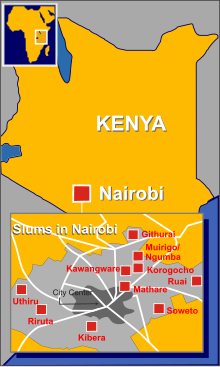Kibera

Kibera is a slum in the southwest of Nairobi , the capital of Kenya . The name Kibera is derived from kibra , which means something like forest or jungle.
location
Kibera covers an area of 2.5 square kilometers 7 km southwest of the city, which is divided into several seamless sub-settlements: Kianda, Soweto (east and west), Gatwekera (Gatuikira), Kisumu Ndogo, Lindi, Laini Saba, Siranga / Undugu, Makina and Mashimoni. The Nairobi- Kisumu railway line runs right through the tin roof settlement . In the north, a golf course borders the slum.
population
Founded in 1920 as a settlement of Nubian soldiers, Kibera, with an estimated population of over one million, was not only the largest slum in Nairobi, but also in the whole of Africa. However, recent studies have shown that the actual number of inhabitants is far below the figures given by the authorities. Doubts about the high population exist due to the fact that Kibera is limited to a few square kilometers.
In 2010, the UN estimated the total population of Kibera at 500,000 to 700,000 people and named population densities of more than 2,000 people per hectare. According to censuses in 2009, Kenya's chief statistician Collins Opiyo was certain that around 200,000 people lived in Kibera, not the assumed one million. According to a 2009 census ( The 2009 Kenya Population and Housing Census ), the population of Kiberas was 170,070. Numbers around 200,000 (199,959 to 205,108) were obtained from the determination of the number of huts using satellite photos and that of the residents of a sample area. The Map Kibera Project provides a compilation of the various data on the population (and possible reasons for this).
The population is made up of different ethnic groups, the majority from Kikuyu . The Kikuyu have controlled the administration since 1974. The Mungiki movement, widespread among the Kikuyu in Kibera , planned to capture the parliamentary seat of Raila Odinga in the constituency of Langata (which, apart from Kibera, also includes the smaller suburbs of Karen and Lang'ata ) in the 2007 parliamentary elections , but this did not succeed .
The outbreaks of violence in Kenya after the 2007 election started in Kibera, where the Luo attacked the Kiluya and partly displaced it.
care
The UN Habitat is headquartered near Kibera and has an annual budget of over 100 million US dollars. According to Habitat Director Sharad Shankardass, the UN has so far spent $ 500,000 on Kibera. Among other things, a detailed study of the Soweto East district has been carried out. 71,000 people live here on 2 hectares. You have 15 bathrooms and 100 toilets at your disposal. Usually six to seven family members live in a three by three meter room without windows, electricity and toilet. The UN has had a toilet with a toilet bowl built, which costs four Kenya shillings (four euro cents) to use. A 20-liter water container costs 3–20 shillings (3–20 euro cents) in Kibera, depending on the time of year.
The pollution from waste, sewage and faeces is extremely high, and accordingly the rate of disease caused by it. In Kibera and elsewhere, people are beginning to disinfect drinking water - at least partially - by exposing it to solar radiation in PET bottles .
Film adaptations
The film The Eternal Gardener by Brazilian director Fernando Meirelles from 2005 was shot in Kibera, among others. Hawa Essuman drew an impressive portrait of Kibera with Soul Boy (2010). Parts of the television series Sense8 by the Wachowski siblings and J. Michael Straczynskis (2015) are set in Kibera.
Picture gallery
literature
- The water preacher. In: Der Spiegel . 29/2007, July 16, 2007.
- David Signer, Lost in Kibera In: Neue Zürcher Zeitung of May 10, 2017.
Web links
See also
Individual evidence
- ↑ UN Habitat in 2010 on Kibera ( Memento of the original from November 5, 2013 in the Internet Archive ) Info: The archive link was automatically inserted and not yet checked. Please check the original and archive link according to the instructions and then remove this notice.
- ↑ Muchiri Karanja: Myth shattered: Kibera numbers fail to add up.Daily Nation , September 3, 2010, accessed November 5, 2013 .
- ↑ Map Kibera Project
- ↑ David Signer, Lost in Kibera In: Neue Zürcher Zeitung of May 10, 2017.
Coordinates: 1 ° 19 ′ S , 36 ° 47 ′ E







